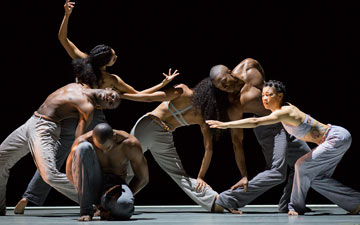
© Paul Kolnik. (Click image for larger version)
Alvin Ailey American Dance Theater
A Song for You, Toccata from Come And Get the Beauty of it Hot, After the Rain pas de deux, Exodus, Revelations
New York, David H. Koch Theater
12 June 2015
www.alvinailey.org
That Ailey Feeling
Alvin Ailey American Dance Theater is back at the Koch Theater for its third spring season at Lincoln Center. On first impact, the Koch is a slightly cold, cavernous house for this company. One wants to see the dancers close up, feel their warmth and personalities the way one does in the more intimate City Center. (The company still dances there every December.) But nothing, not even the dark, empty orchestra pit or the not-very-satisfactory sound system can bring Revelations down. The recordings are as familiar as the choreography itself. The whole ballet feels like a ritual offering. The audience starts clapping before it even begins, and by the end, it is on its feet, dancing along. The encore is de-rigueur. This is dance as communal experience, like the moment in a church service when everyone turns to his or her neighbor to extend a blessing. One is never sorry to have seen another Revelations.
Tonight’s cast was particularly fine, with a dignified, introspective Linda Celeste Sims and Glenn Allen Sims paired in the sober “Fix Me Jesus” pas de deux, a statuesque Jacqueline Green as the umbrella-wielding high priestess in “Wade in the Water,” and the silky-smooth Matthew Rushing as the man receiving baptism in the river. (Rushing, who is now the company’s rehearsal director, seems to grow more focused, more musical, with each passing year.) Even the man who carried the fringed white flag, Michael Jackson, Jr., did so with such feeling that he got a special cheer from the audience.

© Gert Krautbauer. (Click image for larger version)
The night was dedicated to the late Dudley Williams, a longtime dancer who died just a few weeks back at the age of 75. In a heartfelt curtain speech, her voice cracking with emotion, Judith Jamison, former artistic director, mentioned that Williams had been the longest serving company-member in the company’s history – over four decades. A solo created for him by Ailey, “A Song For You,” opened the program. It was danced here by four men, led by Matthew Rushing. There was nothing particularly original about the solo itself, but it had that Ailey soulfulness, the sense of striving for the light and stretching into space, using the back and the abdominal muscles and the thighs to show the effort that goes into living. (In a way, the dance is like a vertical version of the famous “I Wanna be Ready” solo from Revelations, a Dudley Williams specialty.)
Linda Celeste Sims and Glenn Allen Sims danced a glamorous rendition of the pas de deux from Christopher Wheeldon’s After the Rain, originally made for Wendy Whelan, of New York City Ballet. Their performance had none of the delicacy one usually associates with this moody little dance. This was partly due to the rather metronomic recording of the music – Arvo Pärt’s lacrimose “Spiegel Im Spiegel” – and partly due to the lack of accents in the dancing. Without atmosphere and vulnerability the duet becomes nothing but a series of special effects.
The two novelties of the evening were a revival and restaging of the “Toccata” from Talley Beatty’s 1960 work Come and Get the Beauty of it Hot and a new piece by the hip-hop choreographer Rennie Harris, Exodus. The first is a high-energy number for an ensemble of sixteen, set to music for jazz orchestra by Lalo Schifrin. (It was danced to a muffled recording of Dizzy Gillespie’s jazz orchestra.) The patterns are as busy as the crowds that fill the sidewalks of New York, the look is jazzy. Dancers high-kick, shake their hips, and hold their arms out with palms open; they launch into clean, crisp grand jetés; they slide down into splits. It’s a period piece, a slice of Broadway pizzazz transferred to the Ailey stage. (Aspects of it reminded me of West Side Story.) Performed on its own like this, though, it looked rather out of place, like a grand finale without a buildup.

© Paul Kolnik. (Click image for larger version)
Harris’s Exodus, on the other hand, felt just right. Like so many pieces in the Ailey repertory, it suggests a spiritual quest, a journey toward the light. It begins in near darkness with a smoky beam shining down on the god-like Jamar Roberts: a mountain of a man with the gentlest of auras. He is the spiritual leader of his flock, tending to individuals in their moment of need. He consoles a woman (Hope Boykin) who weeps over the body of a fallen man, then brings the man back to life. (It is a particularly resonant image at a time when every day seems to bring news of a black man being shot in the streets.) His lips move, as if he were speaking, or preaching, or warning the others. Late in the dance, he seems to suffer a crisis of faith and falls back into the arms of his followers, now dressed in angelic white, who sustain him.
The footwork is light and quick; the dancers’ upper bodies sway and bend from the waist. It’s a style of dancing that gets under your skin, makes you want to move. Harris creates patterns that ripple across the ensemble while preserving an improvisatory feel. The dancers move in slight counterpoint to each other, resisting unison but remaining compellingly in sync. There are no stars, just characters whose stories bubble to the surface. The dancers touch their hearts and clap their hands as if responding to a common impulse.
The style fits the dancers well: virtuosity repurposed as spiritual exercise. Which, in a way, is spirit of Ailey in a nutshell.

















You must be logged in to post a comment.